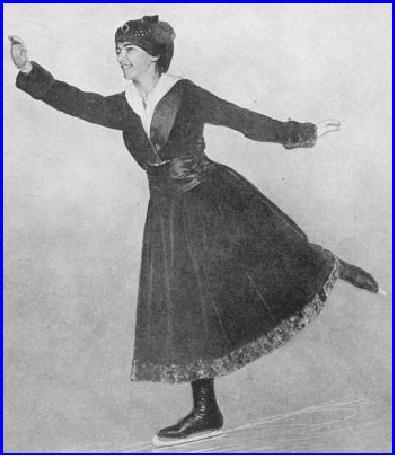 |
STUDYING LINE AND COLOUR IN RUSSIA |
| << LINE AND COLOUR OF COSTUMES IN HUNGARY |
| MARK TWAIN'S LOVE OF COLOUR IN ALL COSTUMING >> |

neck
hung strings of coral and amber
beads. There was indeed a decorative
woman!
As
for her background, it was
simple enough to throw into
relief the brilliant
vision
that
she was. Not, however, a
scheme of interior decoration to
copy! The walls
were
whitewashed; a large stove of
masonry was built into one
corner, and four
beds and a
cradle stood on the other
side of the room, over
which hung in a row
five
virgins, the central one
being the Black Virgin
beloved by the Poles.
The
legend
is that the original was
painted during the life of
the Virgin, on a panel
of
dark
wood. Here, too, was the
marriage chest, decorated
with a crude design in
bright
colours. The children, three
or four of them, ran about
in the national
costume,
miniatures of their mother,
but barefoot.
It
was the same in Hungary,
when we were taken by the
mayor of a Magyar town
to
visit
the characteristic farmhouse of a
highly prosperous farmer, said to be
worth
two
hundred thousand dollars.
The table was laid in
the end of a room having
four
beds
in it. On inquiring later, we
were told that they
were not ordinarily used by
the
family,
but were heaped with
the reserve bedding. In other
words, they were
recognised
by the natives as indicating a
degree of affluence, and were a
bit of
ostentation,
not the overcrowding of
necessity.
CHAPTER
XXII
STUDYING
LINE AND COLOUR IN RUSSIA
ROM
Hungary we
continued our quest of line and
colour of folk
costume
into Russia.
Strangely
enough, Russia throws off
the imperial yoke of
autocracy,
declaring
for democratic principles, at
the very moment we undertake
to put into
words
the vivid picturesqueness resulting
largely from the causes of
this astounding
revolution.
Have you been in Russia?
Have you seen with
your own eyes any
phase
of
the violent contrasts which
at last have caused the
worm to turn? Our
object
being
to study national characteristics as
expressed in folk costume,
folk song, folk
dance,
traditional customs and f�tes, we
consulted students of these
subjects, whom
we
chanced to meet in London, Paris, Vienna
and Buda Pest, with
the result that we
turned
our faces toward southern or
"Little" Russia, as the part least
affected by
cosmopolitan
influences.
Kiev
was our headquarters, and it is well to say at once
that we found what we
sought,--ample
opportunity to observe the genuine
Russian, the sturdy,
dogged,
plodding
son of toil, who, more
than any other European
peasant seems a part
of
the
soil, which in sullen
persistency he tills. We knew
already the Russians of
Petrograd
and Moscow; one meets them
in Paris, London, Vienna, at German
and
Austrian
Cures and on the Riviera. They
are everywhere and always
distinctive by
reason
of their Slav temperament; a
magnetic race quality which
is Asiatic in its
essence.
We recognise it, we are stirred by
it, we are drawn to it in
their literature,
their
music, their painting and in
the Russian people themselves.
The quality is an
integral
part of Russian nature;
polishing merely increases
its attraction as with
a

gem.
One instance of this is the
folk melody as treated by Tschaikowsky
compared
with
its simple form as sung or
danced by the
peasant.
PLATE
XXVIII
A
skating costume worn by Miss
Weld of
Boston,
holder of the Woman's
Figure
Skating
Championship.
This
photograph was taken in New
York on
March
23, 1917, when amateurs contested
for
the
cup and Miss Weld won--this
time over
the
men.
The
costume of wine-coloured
velvet
trimmed
with mole-skin, a small close
toque
to
match, was one of the most appropriate
and
attractive
models of 1916-1917.
Courtesy
of New York Herald Modern
Skating
Costume
1917 Winner of Amateur Championship of
Fancy
Skating
Some
of the Russian women of the
fashionable world are very
decorative. Our first
impression
of this type was in Paris, at the
Russian Church on Christmas
(or was it
some
other holy day?) when to
the amazement of the uninitiated
the Russian
women
of the aristocracy appeared at
the morning service hatless and in
full
evening
dress, wearing jewels as if
for a function at some
secular court. Their
masculine
escorts appeared in full regalia,
the light of the altar
candles adding
mystery
to the glitter of gold lace and
jewels. Those occasions are
picturesque in
the
extreme.
The
congregation stands, as in the Jewish
synagogues, and those of highest rank
are
nearest
the altar, invariably ablaze
with gold, silver and
precious stones, while on
occasions
the priest wears cloth of
gold.
In
Paris this background and
the whole scene was accepted
as a part of the
pageant
of
that city, but in Kiev it
was different. There we got
the other side of the
picture;
the
man and the woman who
are really Russia, the
element that finds an outlet
in
the
folk music, for its
age-old rebellious submission.
One hears the soul of
the
Russian
pulsating in the continued
reiteration of the same
theme; it is like the
endless
treadmill of a life without
vistas. We were looking at
the Russia of Maxim
Gorky,
the Russia that made Tolstoy
a reformer; that has now
forced its Czar to
abdicate.
We
reached Kiev just before
the Easter of the Greek
Church, the season when
the
pilgrims,
often as many as fifty
thousand of them, tramp over
the frozen roads
from
all
parts of the empire to expiate
their sins, kneeling at the
shrine of one of their
mummied,
sainted bishops.
The
men and women alike, clad in
grimy sheepskin coats, moved like
cattle in
straggling
droves, over the roads
which lead to Kiev. From a distance
one cannot
tell
man from woman, but as
they come closer, one sees
that the woman has
a
bright
kerchief tied round her
head, and red or blue peasant
embroidery dribbles
below
her sheepskin coat. She is as stocky as a
Shetland pony and her face
is
weather-beaten,
with high cheekbones and
brown eyes. The man wears a
black
astrachan
conical cap and his hair is
long and bushy, from rubbing
bear grease into
it.
He walks with a crooked
staff, biblical in style, and carries
his worldly goods in
a
small bundle flung over
his shoulder. The woman
carries her own small
burden.
As
they shuffle past, a stench
arises from the human
herd. It comes from
the
sheepskin,
which is worked in, slept
in, and, what is more,
often inherited from
a
parent
who had also worn it as his
winter hide. Added to the
smell of the sheepskin
is
that of an unwashed human,
and the reek of stale food,
for the poorest of
the
Russian
peasants have no chimneys to
their houses. They cannot
afford to let the
costly
heat escape.
Kiev,
the holy city and capital of
Ancient Russia, climbs from
its ancestral
beginnings,
on the banks of the River
Dneiper, up the steep sides
and over the
summit
of a commanding hilltop, crowned by an
immense gold cross,
illumined
with
electricity by night, to flash
its message of hope to foot-sore
pilgrims. The
driver
of our drosky drove us over
the rough cobbles so rapidly,
despite the hill,
that
we were almost overturned. It is
the manner of Russian drosky
drivers. The
cathedral,
our goal, was snowy-white,
with frescoes on the outer
walls, onion-
shaped
domes of bronze turned
green; or gold, or blue with
stars of gold.
We
entered and found the body of
the church well filled by
peasants, women and
men
in sheepskin. One poor doe-eyed creature
crouched to press his
forehead
twenty
times at least on the stone floor of
the church. Eagerly, like a
flock of sheep,
they
all pushed forward to where a
richly-robed priest held a
cross of gold for
each
to
kiss, taking their proffered
kopeks.
Table of Contents:
- A FEW HINTS FOR THE NOVICE WHO WOULD PLAN HER COSTUMES
- THE LAWS UNDERLYING ALL COSTUMING OF WOMAN
- HOW TO DRESS YOUR TYPE
- THE PSYCHOLOGY OF CLOTHES
- ESTABLISH HABITS OF CARRIAGE WHICH CREATE GOOD LINE
- COLOUR IN WOMAN'S COSTUME
- FOOTWEAR
- JEWELRY AS DECORATION
- WOMAN DECORATIVE IN HER BOUDOIR
- WOMAN DECORATIVE IN HER SUN-ROOM
- I. WOMAN DECORATIVE IN HER GARDEN:WOMAN DECORATIVE ON THE LAWN
- WOMAN AS DECORATION WHEN SKATING
- WOMAN DECORATIVE IN HER MOTOR CAR
- HOW TO GO ABOUT PLANNING A PERIOD COSTUME
- I. THE STORY OF PERIOD COSTUMES:II. EGYPT AND ASSYRIA
- DEVELOPMENT OF GOTHIC COSTUME
- THE RENAISSANCE
- EIGHTEENTH CENTURY
- WOMAN IN THE VICTORIAN PERIOD
- SEX IN COSTUMING
- LINE AND COLOUR OF COSTUMES IN HUNGARY
- STUDYING LINE AND COLOUR IN RUSSIA
- MARK TWAIN'S LOVE OF COLOUR IN ALL COSTUMING
- THE ARTIST AND HIS COSTUME
- IDIOSYNCRASIES IN COSTUME
- NATIONALITY IN COSTUME
- MODELS
- WOMAN COSTUMED FOR HER WAR JOB
- IN CONCLUSION